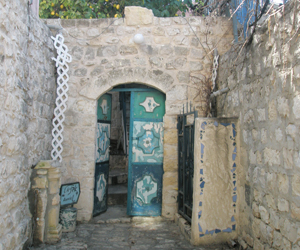Tzfat Genealogy
Who Lived in Tzfat?
Visitors to Tzfat are often mesmerized by the city. The cobblestones, the stone houses and synagogues, the narrow alleyways - all contribute to an atmosphere of history, of Jewish traditions and communities, and of mysticism. A question which is frequently thrown out by people who are in the midst of this enchantment is "how much does a house here cost?"
There are probably few questions which have more answers. Within what would account for an American neighborhood "block", one can find properties that range in price from $50,00 - $500,000. Some have gardens, and some not. Some are 25 square meters, some are 250 square meters. Some are completely updated and modern, others have plumbing and electricity that dates back to WWI. Some have no plumbing or electricity at all!
The most frustrating aspect about buying a house in the Jewish Quarter of Tzfat, however, is the question of ownership. Tzfat is one of the few areas in Israel where Jews have owned property for centuries. Ownership of these properties has passed from generation to generation, from parents to children, for, in some cases, hundreds of years. Today, one can find properties that have dozens, and sometimes hundreds of owners.
Finding the owners of these properties is an exercise in patience and stubbornness. Stories abound of buyers who pursued the descendents of the original owners for years until they were able to buy at least a majority of the property. This would not give them full title to the property, but they would be able to claim the property. One well-known Tzfat story goes back to the 1980s, when a potential buyer heard that there was a family wedding scheduled where many of the descendents of the original owner would be present. He arrived at the wedding with the papers and a checkbook in hand, toasted the couple, and made the rounds of the guests, obtaining their signatures on the sale.
Tracing Families
Tracing families in Tzfat is tricky. There are some records available, mostly lists of children enrolled in schools, residents of the Old Age home, synagogue donors, etc. One of the most enterprising projects is that of the Tzfat Fund, which uses the services of a well-known local guide to map out the cemetery. Chaim Sidor comes to Tzfat on frequent visits and spends his time in the cemetery, trying to read the old gravestones, some of which date back hundreds of years. Many of these stones are unreadable, but enough are legible so that slowly, Chaim is building up a database (available on the web) of people who lived in Tzfat. Since Jewish gravestones traditionally list the names of the deceased's parents, many family connections have been discovered in this manner.
The other method of tracing family in Tzfat is through old stories. This happens frequently ... someone shows up and starts asking about the something-or-other family. There are still enough old-timers in Tzfat that one can be assured that, if enough time is spent, and enough people are asked, the family will be remembered. Unfortunately for many researchers, however, the family skeletons are also remembered, and too often, stories that should have remained buried come to life. Genealogy is a tricky science, especially in Tzfat.

